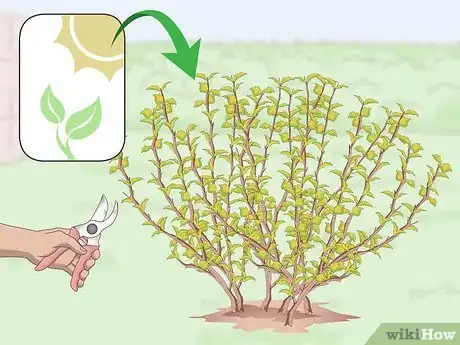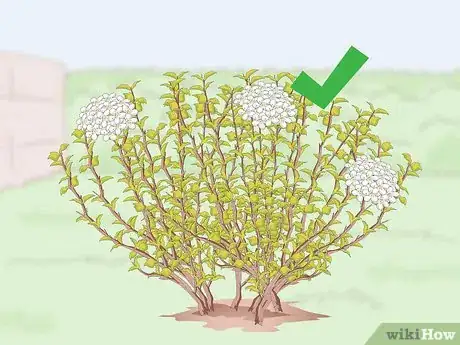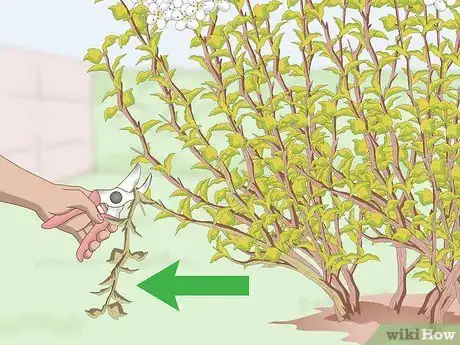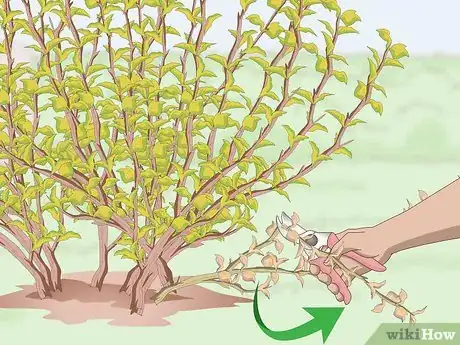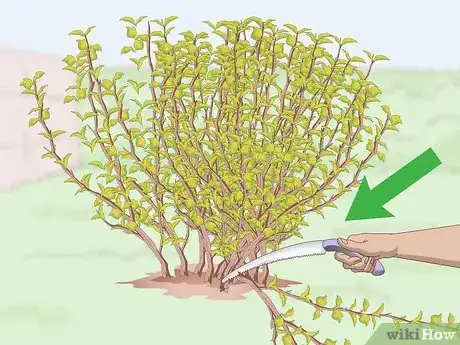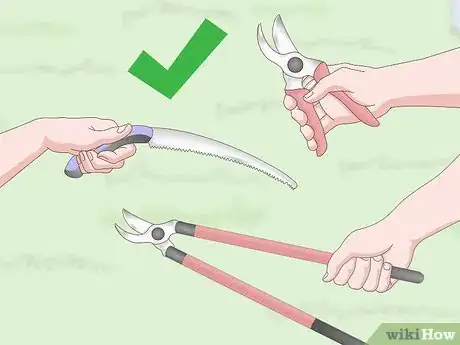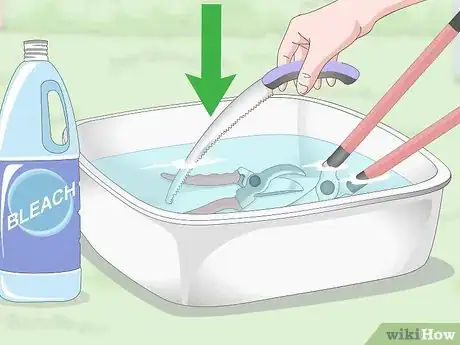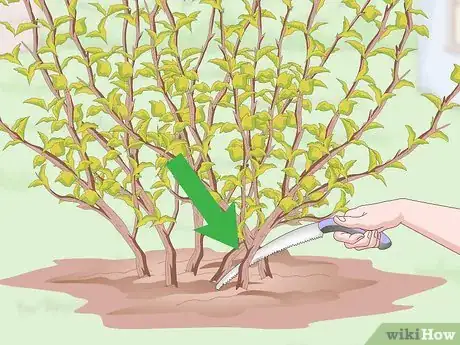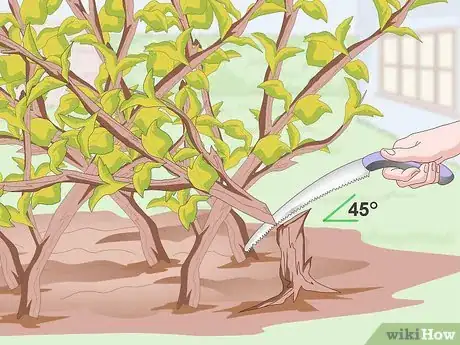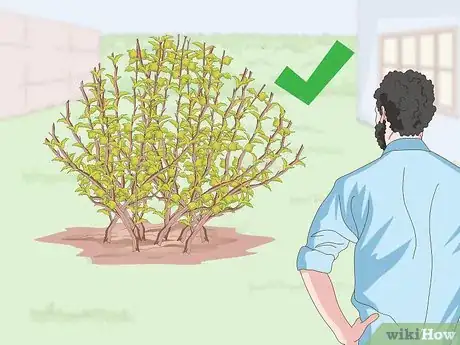This article was co-authored by wikiHow Staff. Our trained team of editors and researchers validate articles for accuracy and comprehensiveness. wikiHow's Content Management Team carefully monitors the work from our editorial staff to ensure that each article is backed by trusted research and meets our high quality standards.
This article has been viewed 71,542 times.
Learn more...
Ninebark is a popular shrub for landscaping because it is low-maintenance and it comes in attractive varieties. It is also resistant to most plant diseases and grows easily. If you have a ninebark, you will need to prune it at least once per year to keep it healthy. Choose the best time to prune, identify the areas that would benefit from pruning, and use proper pruning techniques to ensure that your ninebark remains healthy and beautiful for years to come!
Things You Should Know
- Prune ninebark early in the growing season, after flowers appear but before it develops too much.
- Remove dead branches and leaves, thin out overcrowded stems and branches, and cut off weak or spindly shoots.
- Choose an appropriate tool to prune and make 45-degree angle cuts, trimming back branches almost to the ground and disinfecting your tools after.
Steps
Choosing When to Prune Ninebark
-
1Prune early in your region’s growing season. It is usually best to prune ninebark before it starts to develop too much, which will be sometime between late winter and early summer depending on your climate. Consider when the growing season usually begins in your region to determine when to prune ninebark.[1]
- For example, if you live somewhere that starts to get warm around February or March, then you may need to prune early. If it doesn’t start to get warm until June in your area, then you may not need to prune until later.
-
2Wait for flowers to appear. Ninebark will start to flower early in the growing season, so this is a good indication that it is time to prune. Wait for flowers to start appearing on your ninebark and then prune it.[2]
- Avoid waiting to prune for more than a few days after the flowers appear because this may damage the ninebark and the plant will start growing and expanding, which will create more work for you.
Advertisement -
3Perform light pruning in early summer to get rid of damaged and unhealthy branches. After your initial pruning at the start of the growing season, you may need to do some maintenance pruning during the early part of summer. Pay attention to how the plant develops and prune as needed to keep it healthy and looking its best.
- Do not prune ninebark past the middle of summer because the ninebark will be entering its dormant phase and pruning at this time may damage it.
Identifying Where to Prune Ninebark
-
1Remove dead and damaged branches and shoots. Check the ninebark for any branches that have died or that are broken during your maintenance pruning. Cut these down to the ground or as close to the connecting branch as you can.[3]
- Don’t cut the branches down to stubs. Remove them completely.
- The leaves on dead stems and branches will be dry and crunchy or nonexistent. Branches that are sick or dead may have flaky bark that looks different from the bark on the rest of the shrub.
-
2Thin out stems and branches in areas that are overcrowded. Check the interior of your ninebark during maintenance pruning to see how well the stems and branches are spaced out. If they look crowded, then remove some of them to thin them out and promote healthier growth. Make sure to cut them all the way down to the connecting branch.[4]
- For example, if you find an area of the shrub where the branches are rubbing together, remove a few of the branches so that they are not rubbing together anymore.
- You may also notice that some areas of the ninebark are so full of foliage that no light can get through to the interior of the plant. This may be the case even if the branches are spaced out. Thin out these areas by cutting out some of the stems and their connecting leaves.
-
3Eliminate weak or spindly shoots. If during maintenance pruning you spot any shoots that look weak (sagging or flimsy) or spindly (with few leaves or flowers), then remove these. Cut them as close to the connecting branch as you can. Don’t leave any stubs.[5]
- Pruning shears work well for pruning shoots.
Using Proper Pruning Techniques
-
1Choose the right tool for the cut you need to make. The type of tool you use will depend on the area of the ninebark you are pruning. Depending on the size of your ninebark, you may need 1 tool for shoots and stems and another tool for branches. Some common pruning tools include:
- Pruning shears. Pruning shears are best for cutting through branches that are up to 0.75 in (1.9 cm) in diameter.
- Loppers. Loppers, or lopping shears, work well for cutting through branches that are up to 1.5 inches (3.8 cm) in diameter.
- Hand saw. You may need a hand saw to remove branches greater than 1 in (2.5 cm) in diameter. Some hand saws are even strong enough to cut through branches as thick as 4 inches (10 cm) in diameter. For anything thicker, use a chainsaw.
-
2Disinfect your tools after using them. To prevent the spread of diseases among diseased and healthy plants, it is important to disinfect your gardening tools after using them. First, rinse your tools off with clean water. Then, mix up a disinfectant solution made up of 1 part bleach and 9 parts water. Soak your tools in the solution for 30 minutes and then rinse them off with clean water. Let them air dry or dry them with a clean towel before storing them.[6]
-
3Cut branches nearly down to the ground. It is important to cut any branches you remove near the ground. Otherwise, they may hinder the growth of the ninebark and they will affect the appearance of the shrub as well.
- You can even cut the entire shrub nearly down to the ground if it is out of control.
-
4Make cuts in branches at about 45-degree angles. Whenever you need to remove a branch, cut it at a 45-degree angle. The lowest part of the branch should be even with the connecting branch and the highest part of the branch should be about 0.25 inches (0.64 cm) from the connecting branch.[7]
-
5Leave the base of the shrub wider than the top. It is important to leave the bottom of the shrub wider than the top of the shrub after you prune it or the bottom of the shrub will not get adequate light. This could cause the ninebark to grow poorly. Prune the shrub at a slight angle so that there is a gradual thickening towards the base.
- For example, you could prune the ninebark into a pyramid-type shape with a rounded top.
-
6Maintain symmetry in your pruning. For aesthetic reasons, make your cuts with symmetry in mind. If you cut a branch on 1 side of the shrub, make sure that the opposite side has a similar angle to it. Step back and look at your shrub now and then to ensure that you are keeping it symmetrical.
Community Q&A
-
QuestionWhat do I do if branches on ninebark look dead on the inside, but the ends are blooming?
 Community AnswerPut small cuts in the branch starting from the end and working your way toward the trunk. If it is green, it is fine; if it is dry, cut it off.
Community AnswerPut small cuts in the branch starting from the end and working your way toward the trunk. If it is green, it is fine; if it is dry, cut it off. -
QuestionMy ninebark has a bad case of powdery mildew. I have not been able to keep under control. Should I cut it right down to the ground? I have a very large flower garden and am concerned.
 Bani SCommunity AnswerFirst, prune the leaves that are heavily infected. Then sprinkle some cinnamon powder on the entire plant. This is highly effective, however slightly heavy on the wallet!
Bani SCommunity AnswerFirst, prune the leaves that are heavily infected. Then sprinkle some cinnamon powder on the entire plant. This is highly effective, however slightly heavy on the wallet! -
QuestionExactly how late can I prune? All my nine barks are out of control and I am super reluctant to hard cut as this is the first year out of several that they have grown well.
 Lillie BurgessCommunity AnswerIt is best to prune and trim your ninebark shrub during its dormant period, after the end of fall and before the start of spring. Once the plant has stopped blooming, you can perform some light pruning to remove any stray branches.
Lillie BurgessCommunity AnswerIt is best to prune and trim your ninebark shrub during its dormant period, after the end of fall and before the start of spring. Once the plant has stopped blooming, you can perform some light pruning to remove any stray branches.
Things You’ll Need
- Pruning shears
- Loppers
- Hand saw
- Gardening gloves
- Bleach
- Water
- Clean towel
References
- ↑ https://www.rhs.org.uk/advice/profile?PID=197
- ↑ https://www.rhs.org.uk/advice/profile?PID=197
- ↑ https://www.rhs.org.uk/advice/profile?PID=197
- ↑ https://www.rhs.org.uk/advice/profile?PID=197
- ↑ https://www.rhs.org.uk/advice/profile?PID=197
- ↑ http://gardeningsolutions.ifas.ufl.edu/care/tools-and-equipment/disinfecting-tools.html
- ↑ https://www.sunset.com/garden/garden-basics/basic-pruning-cuts
